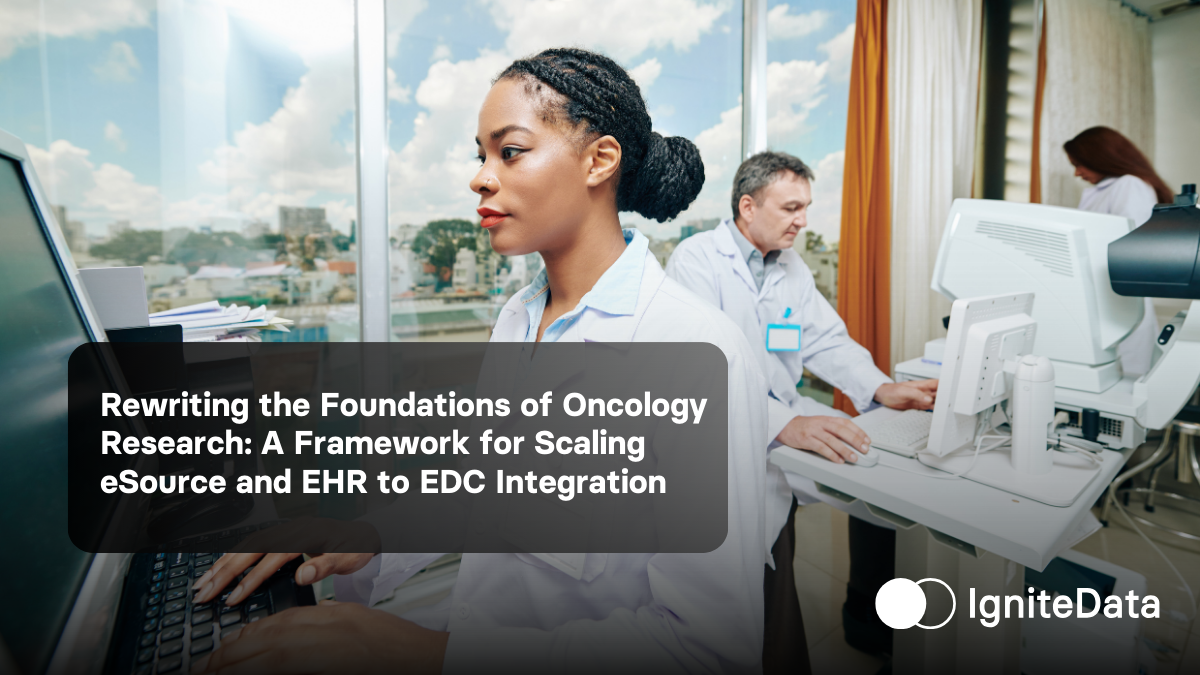Oncology research is experiencing a period of rapid structural change. Precision medicine, multimodal data integration, and increasingly complex study protocols have placed heavy demands on traditional clinical trial systems. Many research programs still rely on manual workflows that were designed for a different era. These workflows cannot support the volume, variety, and velocity of data generated in modern oncology trials. They also create persistent vulnerabilities related to accuracy, compliance, and operational efficiency.
To address these challenges, research organizations are shifting toward digitally enabled methods that automate the movement of clinical data from electronic health record systems into electronic data capture platforms. This automated model, often referred to as eSource enabled EHR to EDC integration, is becoming a central component of contemporary clinical operations. Successful adoption, however, requires more than new technology. It requires a comprehensive framework that includes governance, readiness, interoperability, and a structured plan for scale.
The Data Demands of Modern Oncology Trials
Oncology trials generate highly complex datasets. The rise of precision oncology has introduced a wide variety of new data types, including genomic sequences, advanced imaging, biomarker panels, real world data, and longitudinal treatment histories. Each data type carries unique formatting, timing, and validation requirements. Phase I oncology studies now commonly involve tens of thousands of data points for each participant. Every data point must be captured, reviewed, and verified with care.
Many institutions still depend on manual chart review and transcription to move information from the EHR into study databases. This process is slow, resource intensive, and prone to inconsistency. Clinical Research Coordinators and data managers often spend a majority of their time re entering information that already exists elsewhere in digital form. Sponsors respond to these risks with intensive source data verification, which further extends timelines and increases operational cost.
This dynamic creates barriers to efficiency, scalability, and high quality research execution.
eSource as a Mechanism for Reducing Burden and Strengthening Data Integrity
Automated EHR to EDC integration offers a direct, validated, and regulatory aligned method for digital data transfer. Through eSource, structured clinical data moves from the point of care to the research database with full traceability and without manual transcription. This approach provides several advantages that are especially relevant for oncology research.
1. Improved Accuracy and Consistency
Manual transcription introduces human error. Automated transfer improves adherence to ALCOA principles because data remains original, accurate, complete, and contemporaneous.
2. Reduced Site Burden
By eliminating repetitive data entry, eSource allows clinical research personnel to focus on patient engagement, protocol compliance, and real time issue resolution.
3. More Efficient Monitoring and Oversight
Higher initial data quality reduces the frequency of discrepancies and queries. It also reduces the amount of SDV required by sponsors and contract research organizations.
4. Shorter Timelines from Data Capture to Submission
Automated workflows reduce delays that often occur in the period between patient visits and database availability.
5. Better Support for Precision Medicine
Trials that rely on complex genomic, imaging, or real world data benefit from structured, standards based interoperability and automation.
A Framework for Scalable eSource Adoption
Successful eSource adoption requires a structured approach that includes three foundational components: institutional readiness, performance measurement, and phased implementation.
1. Institutional Readiness: Building a Strong Foundation
Institutions must assess their capabilities across governance, regulatory alignment, technical infrastructure, and operational workflows. Effective readiness planning includes:
- Governance coordination across research leadership, clinical operations, IT, and compliance teams
- Infrastructure readiness that supports standards based data exchange, including FHIR based interoperability
- Workflow standardization that aligns clinical processes with research activities
- Clear regulatory alignment with Good Clinical Practice and privacy requirements
- Training and capacity planning for CRCs, data managers, and informatics teams
Strong readiness planning helps avoid operational friction during deployment.
2. Performance Indicators: Measuring Impact and Guiding Continuous Improvement
A consistent set of performance indicators allows institutions to evaluate the effectiveness of eSource implementations. Key indicators include:
- Data accuracy
- Data completeness
- Reduction in SDV volume
- Reduction in CRC workload
- Time required for site onboarding
- Time from patient visit to data availability
- Reusability of mapping assets for future studies
- Staff satisfaction and retention
These metrics make it possible to monitor progress and optimize workflows over time.
3. Phased Implementation: A Playbook for Operational Scale
A phased approach ensures that eSource deployment is systematic, compliant, and repeatable.
Preparation
Define objectives, identify stakeholders, evaluate readiness, and establish project governance.
Planning
Map clinical and research workflows, specify data requirements, outline validation processes, and document regulatory considerations.
Setup
Configure integrations, test data flows, validate outputs, train end users, and prepare operational teams.
Execution
Launch automated extraction, monitor system behavior, resolve issues, and refine mappings based on real world use.
Post Implementation Review
Evaluate performance using predefined KPIs, refine workflows, document lessons learned, and create a plan for scale across additional studies or therapeutic areas.
This structured model supports consistent quality and reliable performance across diverse research environments.
The Future of Oncology Research Depends on Digital Infrastructure
Oncology trials are becoming more complex with every passing year. Manual workflows cannot accommodate the increasing scale of data, the complexity of precision medicine, or the expectations of modern regulatory frameworks. Automated EHR to EDC integration is essential for improving data integrity, accelerating timelines, and reducing site burden. It also creates capacity for research teams to manage more studies without compromising quality.
The institutions that invest in digital infrastructure today will be best positioned to lead the next generation of oncology research. eSource adoption is not simply a technical upgrade. It is a foundational shift in how clinical data is captured, validated, and used to accelerate therapeutic development. The benefits are significant for sponsors, for research teams, and most importantly for patients who need faster access to innovative therapies.
